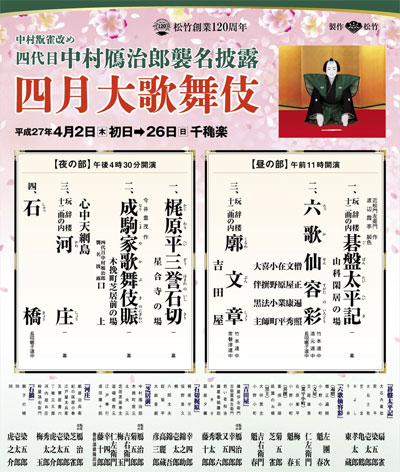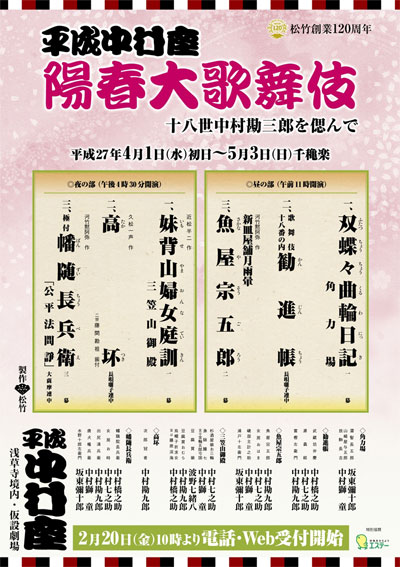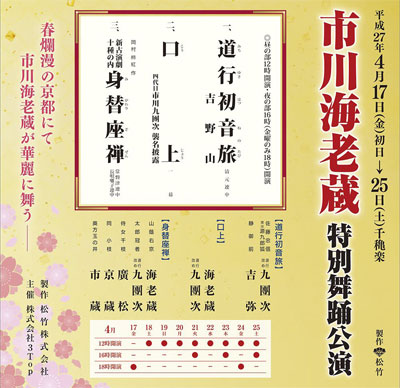| APRIL 2015 |
| Kabukiza (T˘ky˘) |  |
| Dates | 2 ~ 26 April 2015 (Shigatsu ďkabuki) April Grand Kabuki |
| MatinÚe |
Goban Taiheiki (Yamashina Kankyo)
|
| Evening |
Kajiwara Heiz˘ Homare no Ishikiri Narikomaya Kabuki no Nigiwai (K˘j˘) |
| Casting |
Nakamura Ganjir˘, Living National Treasure Sakata T˘jűr˘, Living National Treasure Onoe Kikugor˘, Living National Treasure Nakamura Kichiemon, Matsumoto K˘shir˘, Kataoka Nizaemon, Matsumoto K˘shir˘, Nakamura Baigyoku, Nakamura Senjaku, Nakamura Shibajaku, Ichikawa Sadanji, Nakamura Kaishun, Nakamura T˘z˘, Ichikawa Somegor˘, Kataoka Takatar˘, Kataoka Hidetar˘, Nakamura Kinnosuke, Band˘ Hikosabur˘, Nakamura Karoku, Nakamura Matagor˘, Nakamura Kikaku, Ichikawa Komaz˘, Nakamura Kazutar˘, Matsumoto Kingo, Nakamura Toranosuke |
| Comments |
Nakamura Ganjir˘ IV celebrates his shűmei in T˘ky˘ at the Kabukiza!
|
 |
| Kanamaruza (Konpira) |
| Dates | 11 ~ 26 April 2015 (Shikoku Konpira Kabuki ďshibai) |
| MatinÚe |
|
| Evening | |
| Casting |
Nakamura Tokiz˘, Onoe Kikunosuke, Onoe Sh˘roku, Onoe Matsuya, Band˘ Kamesabur˘, Nakamura Baishi, Band˘ Kametoshi, Onoe Ukon |
| Comments |
31st edition of the Spring Kabuki performance Shikoku Konpira Kabuki ďshibai at the Kanamaruza on Shikoku Island!
|
| Heisei Nakamuraza (T˘ky˘) | |
| Dates | 1 April ~ 3 May 2015 (Y˘shun ďkabuki) Full Spring Merriness Grand Kabuki |
| MatinÚe | |
| Evening | |
| Casting |
Nakamura Kankur˘, Nakamura Shichinosuke, Nakamura Hashinosuke, Band˘ Yajűr˘, Nakamura Shid˘, Kataoka Kamez˘, Nakamura Kotar˘, Band˘ Shingo, Nakamura Tsurumatsu, Nakamura Kunio, Nakamura Muneo, Nakamura Yoshio, Namino Naoya |
| Comments |
The Heisei Nakamuraza is back in T˘ky˘ in Asakusa. There was no Heisei Nakamuraza in T˘ky˘ for 3 years, following the sudden death of its creator Nakamura Kanzabur˘ XVIII. The new zagashira is Nakamura Kankur˘.
|
 |
|
|||
| Dates | 4 ~ 26 April 2015 (Shigatsu Hanagata Kabuki) April Young Actors Kabuki |
||
| MatinÚe |
Yukinoj˘ Henge |
||
| Evening |
Shin Hakkenden |
||
| Casting |
Ichikawa Ennosuke, Kataoka Ainosuke, Ichikawa Ukon, Band˘ Takesabur˘, Ichikawa Monnosuke, Ichikawa Omez˘, Band˘ Shűch˘, Band˘ Minosuke, Sawamura S˘nosuke, Arashi Kitsusabur˘, Nakamura Hayato, Nakamura Mantar˘, Nakamura Tanenosuke, Nakamura Yonekichi, Nakamura Umemaru |
||
| Comments |
A special program in Nagoya with Ichikawa Ennosuke and Kataoka Ainosuke at the top of the bill:
|
||
|
|||
| Dates | 17 ~ 25 April 2015 (Ichikawa Ebiz˘ Tokubetsu K˘en) Ichikawa Ebiz˘ Special Performances |
||
| Program | |||
| Casting |
Ichikawa Ebiz˘, Ichikawa Kudanji, Kataoka Ichiz˘, Kamimura Kichiya, Nakamura Ky˘z˘, ďtani Hiromatsu |
||
| Comments |
Ichikawa Kudanji IV celebrates his shűmei in Ky˘to at the Minamiza with the patronage of the young star Ichikawa Ebiz˘.
|
||
 |
| Ichikawa Ebiz˘ Tour | |
| Dates | 28 February ~ 9 April 2015 (Ichikawa Ebiz˘ Tokubetsu K˘en) Ichikawa Ebiz˘ Special Performances |
| Program |
Genji Monogatari |
| Casting | |
| Comments |
A 18-city tour for Ichikawa Ebiz˘. Among these dates, Ichikawa Ebiz˘ is in Fukuoka at the Hakataza from the 3rd to the 5th of April and in T˘ky˘ at the Orchard Hall the 8th and the 9th of April. |
|
|
| Contact | Main | Top | Updates | Actors | Plays | Playwrights | Programs | Links | FAQ | Glossary | Chronology | Illustrations | Prints | Characters | Derivatives | Theaters | Coming soon | News |